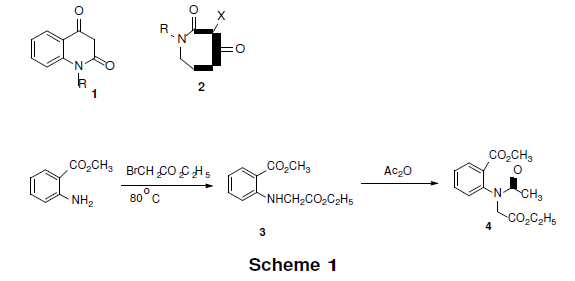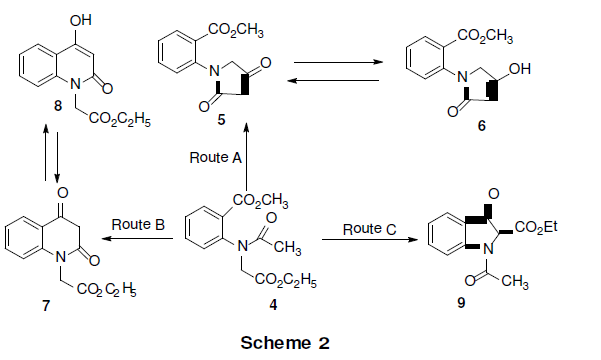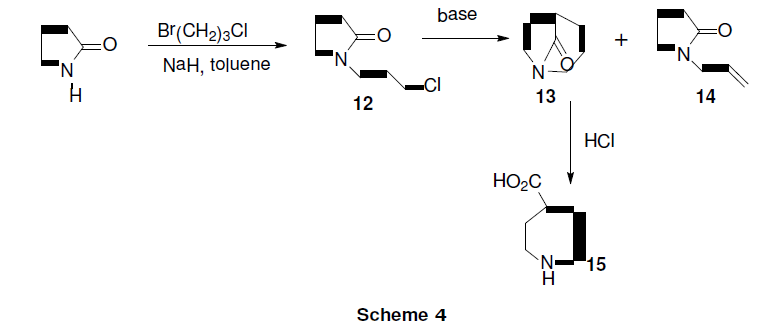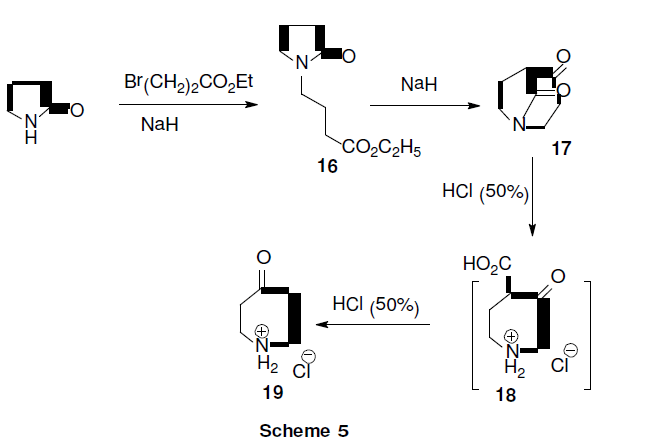e-ISSN: 2319-9849
e-ISSN: 2319-9849
Faculty of Science, Chemistry Department, Damietta University, Egypt.
Received date: 07/04/2015 Accepted date: 12/05/2015 Published date: 15/05/2015
Visit for more related articles at Research & Reviews: Journal of Chemistry
N-acyl derivative 4 was prepared via the reaction of methyl anthranilate with ethyl bromoacetate then refluxing the formed amino ester 3 with acetic anhydride. Cyclization of 4 in presences of sodium methoxide and methanol forming 2,4-pyrrolidindione derivative 5. 2,4-Quinolidinone 6 was obtained via cyclization of 4 in dry toluene and sodium hydride. On the other hand, indolinone derivative 9 was obtained by cyclization of 4 in toluene and free from alcohol due to retro Diekmann condensation. On treatment of 9 with sodium hydride, refluxing toluene and in presences of Crown ether gave tricyclic compound 10 which observed to exist in the enole form 11. Also, treatment of 2-pyrrolidinone with trimethylene chlorobromide produced 12 which cyclized using base and solvent to the bridged ring derivatives 13. The acidic hydrolysis of 13 afforded the corresponding amino acid 15. Whereas derivative 16 was obtained by the reaction of 2-pyrrolidinone with ethyl 3-bromopropionate which on cyclization gave azabicyclo[3,2,1]octan-4,8-dione derivative 17. Compound 17 underwent acidic hydrolysis to the amino ketone derivative azepanone hydrochloride 19.
2,4-pyrrolidindione, Quinolidinone, Indolinone, Tricyclic compound, Carboxy azepane, Azepanone hydrochloride.
It was reported that cyclization of N-acyl derivatives was utilized for the synthesis of heterocyclic system related to alkaloid [1]. It was also found that N-acyl derivatives was a versatile compound for the synthesis of pyrrolidine and its derivatives [2-8].. Pyrrolidin-2,4-dione ring system was found in many natural product scaffolds, and it has a wide range of biological activity [9-13]. Quinolindione derivatives are of great interest due to their role in natural product chemistry and totheir pharmacological activity as antibacterial [14], antifungal, dye-stuffs and herbicides [15,16].
The earlier reported cyclization reactions of methyl N-acetylanthranilate were carried out with a wide variety of bases and solvents and suitable temperature (120°C) to give 2,4-quinolindiones [17,18]. This cyclization reaction needs a fully substituted nitrogen atom in anthranilate to avoid of intramolecular hydrogen bonding between amidic-NH and carbonyl-oxygen atom of the ester for the N-acetyl anthranilate and non-aqueous solvents [19].
The anions generated from the N-acetyl compounds can act as donors Dieckmann- like intramolecular condensation reactions and attacks the ester group in 6-Exo-Trig mode of ring closure forming quinolindione derivative 1 [20]. We were previously studied the 7-Exo-Trig mode of ring closure forming 2,4-azepandione derivative 2 by attack of the N-acetyl carbanion on the ethyl butyrate moiety [21]. Also we had been investigated the 6-Exo-Dig ring closure of the N-acetyl carbanion with cyano group [22].
In the present work, we are interested in the utilization of the N-acyl derivatives in syntheses of the five-membered and bridged ring systems via 5-Exo-Trig and 7-Exo-Trig modes of ring closure, respectively.
Melting points were obtained on digital Gallen Kamp melting point apparatus. The IR spectra were recorded on a Jasco 4100 FTIR Spectrophotometer in KBr discs (v max in Cm-1 ). 1H NMR spectra (CDCl3) and (DMSO-d6) were obtained using Pucker 300 MHz spectrometer and chemical shift values were expressed in values (ppm) relative to that of the solvent. All NH and OH protons were exchangeable with D2O. Elemental analyses were recorded on a PERKIN-ELMER 2400 C, H, N elemental analyzer, Cairo University. Reaction progress was monitored by analytical thin layer chromatography (TLC) on pre-coated glass plate (silica gel 60F254-plate-Merck) and the products were visualized by UV light. Boiling points were determined on the Kugelrohr apparatus.
Methyl 2-{(2-carboethoxyethyl)amino}benzoate (3)
A mixture of methyl anthranilate (15.11 g, 0.1 mole) and ethyl bromoacetate (9.9 g, 0.1 mole) were heated at 80°C for four hours. After cooling, the mixture was dissolved in ethanol and poured onto cold water and extracted with chloroform. After drying and evaporation in vacuum, the residue was purified on column chromatography using ethyl acetate/petroleum ether 10% and gave pure product 3 in 22 g, 92.8% yield, m.p. 38°C. IR λmax (film) cm-1: 1715 (C=O, ester). 1HNMR N (CDCl3) produced 1.21 (t, CO2CH2 CH3), 3.85(t, 3H, CO2 CH3), 4.00 (s, 2H, N-CH2-CO2 Et), 4.70 (q, 2H, CO2CH2 CH3), 6.41, 7.20 and 7.82 (m, 4H, aromatic) and 8.11 (br, 1H, NH, exch.). Anal. Calced for C12H15NO4 (237.25); C: 60.75; H: 6.35; N: 5.90%, found; C: 60.55; H:6.10; N:6.00%.
Methyl [N-acetyl-N-(2-carboethoxyethyl)] anthranilate (4).
Aminoester 3 (23.7 g, 0.1 mole) and acetic anhydride (50 ml) were refluxed at 160°C for 24 h. After cooling, the reaction mixture was poured onto cold water, extracted with chloroform and the residue was dissolveed in aqueous NaHCO solution. Drying and evaporation in vacuo gave the desired product 4, yield 25g, 89.6%, b.p. 160°C/ 0.05 m bar. IR λmax(film) cm-1: 1725 (C=O, ester) and 1670 (C=O, amide). 1HNMR N (CDCl3) ppm: 1.22 (t, 3H, CO2CH2 CH3); 1.85 (s, 3H, COCH3); 3.52-4.90 (dd,2H, N-CH2Co2Et); 3.92 (s, 3H, CO2CH3); 4.19 (q, 2H, CO2CH2 CH3) and 7.41-8.07 (m, 4H, aromatic). Anal. Calced for CH14H17NO5 (279.29); C: 60.2; H: 6.15; N: 5.00%, found; C: 60.01; H: 6.19; N: 5.34%.
Cyclization of compound (4) formation of 2,4-pyrrolidine(5)
By sodium methoxide
Cyclization of compound (4) formation of 2,4-pyrrolidine(5) By sodium methoxide Methanole/ 25°C
The foregoing diester 4 (2.8 g, 0.01mole) in methanol (30ml) was added to sodium methoxide (0.02 mole, 0.46 g) at room temperature with stirring under nitrogen over 1h. The reaction mixture was stirred for further 3h, poured onto cold water-ice mixture and acidified with dil. HCl to give a green precipitate of 5. Recrystallization from ethyl alcohol gave pure pale green solid, yield 2.0, 85.8%, m.p. 152°C. 1HNMR δ (DMSO) ppm: 3.90 {s, 5H, CO2CH3 and C-5(2H)}, 7.02 (4H, aromatic), 9.37 {s, 1H, vinylic (C-3)} and 10.81 (s, 1H, OH enolic). Anal calced for C12 H11 NO4 , (233.22); C: 61.80; H: 4.75; N: 6.01%, found; C: 62.02; H: 4.67; N: 6.25%.
Methanole/ 80°C
Diester 4 (2.8 g, 0.01 mole) in methanol (30 ml) was added to sodium methoxide (0.46 g, 0.02 mole) at room temperature with stirring under nitrogen over 1h. The reaction was allowed to rise to 80°C during 4h, after cooling and addition of cold water, acidified with dil. HCl. The yielded material was collected and purified by chromatography using (2% ethanol + chloroform) mixture to give the compound 5. Yield 47.2%, m.p. 151°C. Compound 7 yield 47.3%, m.p. 105°C. IR λ max (Nujol) cm-1: 1720 (C=O, ester and ketone) and 1680 (C=O, amide). 1HNMR N (CDCl3) ppm: 1.20 (t, 2H, CO2CH2 CH ); 2.20 (s, 2H, C-3); 3.9-5.00 (dd, 2H, N-CH2CO2 Et); 4.20 (q, 2H,CO2CH2CH3 ); and 7.10-7.61(m, 4H, aromatic). Anal calced for C13 H13 NO4 (247.25); C: 63.15; H: 5.30; N: 5.65%, found; C: 62.95; H: 5.40; N: 5.70%.
Toluen/40/80°C
Diester 4 (2.8 g, 0.01 mole) in toluene (50 ml) was added to sodium methoxide in dry toluene (100 ml) dropwise over 30 min at 40°C under nitrogen. The reaction was stirred at this temperature for further 8h, tlc indicated no reaction, the temperature was allowed to rise to 80°C 4h. After cooling annd addition of water, the aqueous layer was separated and acidified to give compound 5 in 40% and compound 7 in 20% yield. The toluene layer was washed with water (×3), dried, evaporated in vacuo and column chromatography purified using dichloromethane: ethanol: ammonia in 300:8:1 mixture to give pure compound 9 in yield 0.8 g, 40%, m.p. 40°C. IR λ max (Nujol) cm-1: 1700 (C=O, ketone and ester) and 1680 (C=O, amide). 1HNMR N (CDCl3) ppm: 1.31 (t,3H, CO2CH2CH3); 2.25 (s, 3H, COCH3); 4.30 (m, 2H, CO2CH2CH3 ); and 7.03 (m, 5H, aromatic and C-3). Anal calced for C13H13 NO4(247.25); C:63.15; H: 5.30; N: 5.67%, found; C: 63.25; H: 5.59; N: 6.00%.
Sodium hydride At 40°C
Diester 4 (2.8 g, 0.01 mol) in toluene (50 ml) was added to sodium hydride (60%, 0.8 g, 0.01 mol) in dry toluene (100 ml) drop wise at 40°C under nitrogen with stirring over 30 min. The reaction was kept at this temperature for further 8h and cooled. Ethanol (excess) and water were added, aqueous layer was separated and acidified with HCl (2M) to give compound 5 (40%) and 7 in 15% yield. Toluene layer was washed with water (×3), dried and evaporated to give compound 9 (45%).
At 80°C
The same procedure as in above one (2a) was applied and the reaction was raised to 80°C for 6h. After cooling and addition of ethanol (excess) and water, aqueous layer was separated, acidified with dil.HCl (2M) to give compound 11. Yield, 0.7 g, (36.8%), m.p. (ethanol) 130°C. IR λ max (Nujol) cm-1: 3360 (OH), 1650 (C=O, amide). 1HNMR N (CDCl3) ppm: 3.95(s, 2H, C-2) and 7.04 (m, 5H, aromatic and C-8a). Anal calced for C11H7NO3 (201.18); C: 65.67; H: 3.51; N: 6.96%, found; C: 66.05; H: 3.25; N: 6.75%. c) At 80-120°C 11 7 3 The same procedure as in (2a), but the addition was completed ate 80oC and, the temperature was raised to 120°C during 4h. After cooling and addition of ethanol and water, the aqueous layer was separated, and acidified to give compound 7 (2.0g, 86.9%).
Cyclization of compound (9) to compound (10)
Solution of compound 9 (2.47g, 0.01 mol) in dry toluene (50 ml) and 15-crown-5 (2 drops) was added dropwise over 30 min to sodium hydride (0.8 g, 0.02 mol) in dry toluene (100 ml) at 80°C. The temperature was allowed to rise to 120°C during 8 h. After cooling, ethanol (excess) and water were added and acidified with dil.HCl (2M) to give compound 10 (1.8 g, 94.7%). 1-(3-Chloropropyl)-2-pyrrolidone (12).
2-Pyrrolidone (8.6 g, 0.1mol) in dry toluene (10ml) was added dropwise over 2h. To sodium hydride (60%, 4.0 g, 0.1mol) in dry toluene (50 ml) at 50°C, then 1-bromo-3-chloropropane (18.9 g, 0.12 mol) was added at once and the reaction mixture was kept 24h at 50°C. After cooling, addition of ethanol (excess) and water, aqueous layer was separated and acidified with dil.HCl (2M). The desired, product 12 was produced in yield (14 g, 85.4% at b.p. 70°C/0.05mbar). IR λ max (film) cm-1: 1630 (C=O, amide) and 3460 (NH). 1HNMR N (CDCl3) ppm: 2.01 (m, 4H, N-CH2 CH2 CH2 Cl and C-4), 2.31 (t, 2H, C-3) and 3.37 (m, 6H, N-CH2 CH2 CH2 Cl, C-5). Anal calced for C7H12ClNO (161.63); C: 52.02; H: 7.48; Cl: 21.93; N: 8.67%, found; C: 52.33; H: 7.35; Cl: 21.70; N: 8.75%.
Cyclization of 1-(3-chloropropyl)-2-pyrrolidone (12) Sodium metal
The title compound 12 (1.6 g, 0.01 mol) in dry benzene (10 ml) was added to sodium (0.02 mol) in benzene (50 ml) at 70°C under nitrogen. The reaction mixture was kept for 24 h. at temperature. After cooling, addition of ethanol (excess) and water, the benzene layer was separated, washed with water (×3), dried and evaporated in vacuo. The produced oil have yield (0.8 g, 65.04% at b.p. 140°C/0.01m. bar) has two peaks at glc (40:60%).
Sodium hydride
The title compound 12 (3.2 g, 0.01 mol) in dry THF (10 ml) was added at once to sodium hydride (0.8 g ,0.02 mol) in THF (60 ml) at 80°C over 5 h under nitrogen. After cooling, addition of ethanol (excess) and cold water, extraction (CH2Cl2 ) gave the same oil as in method (a)( 1.9 g ,77%), b.p. 140°C/0.01m. bar.
Potassium t-butoxide
The title compound 12 ( 3.2 g, 0.02 mol) in dry toluene (30 ml) was added potassium t-butoxide (1.8 g K, 0.02 mol) in toluene (50 ml) at 80°C under nitrogen. The reaction mixture was heated to 125°C for further 24 h, cooled and poured into cold water. The toluene layer was washed with water (×3), dried and evaporated to give the same oil as in method (a) (1.0g ,40.6%, b.p. 140°C/0.01m. bar).
Lithium di-isopropylamide (LDA)
Lithium di-isopropylamide (LDA) was prepared by the addition of n-butyllithium (1.55 M, 5 cm3, 7.75mol) in freshly distilled THF (20 ml) to a stirred solution of di-isopropylamine (2.18 cm3, 15.6 mol) in freshly distilled THF (20 ml) at 0°C under nitrogen and stirred for 15-20 min. A solution of (3-chloropropyl)-2-pyrrolidone (12) (1.2 g, 7.4 mol) in THF (10 ml) was added dropwise at -178°C over 1 h, and stirred at that temperature for further 3 h. The solution was allowed to rise to RT, and then saturated ammonium chloride solution followed by 2M. HCl were added, extracted with chloroform, dried and evaporated to give the desired bridged product 13. Yield 0.8 g, 86.4% at b.p. 140°C/0.01mbar). IR λ max (film) cm-1: 1670 (C=O, amide). 1HNMR N (CDCl3) ppm: 2.02 (m, 2H, C-6), 2.31 (t, 2H, C-3) and 3.35 {m, 3H, C-5 (2H) and C-2 (1H)}, 3.81 {d, 1H, C-2 (H)}, 5.05 (2m, 2H, C-7) and 5.55 (m, 1H, C-4). Anal called for C7H11NO (125.17); C: 67.17; H: 8.86; N: 11.19%, found; C: 66.94; H: 8.52; N: 11.22%. The same result was obtained when sodium hydride was used as a base of cyclization in presence of Crown ether (83.2%).
4-Carboxyazepane hydrochloride (15)
A solution of compound 13 (1.3 g, 0.01 mol) in acetic acid (30 ml) and dil. HCl (100 ml, 50%) was refluxed at 120°C for 48 h. After cooling, the reaction mixture was washed with ether (×3) and evaporated until dryness to give compound 15. Yield (0.78 g, 41.7%), m.p. (ethanol) 213°C. IR λ max (film) cm-1: 1705 (C=O, CO2H) and 3400 (CO H-str.). 1HNMR N (DMSO) ppm: 1.81 (m, 2H, C-6), 2.32 (t, 2H, C-3), 2.80 (m, 2H, C-5), 3.46 (m, 2H and, C-2), 5.43 (dd, 2H, C-7), 4.81 (m, 1H, C-4) and 8.01 – 10.03 (br, 2H, NH and CO2 H exch.). N (D2O) 1.82 (m, 2H, C-6), 2.41( t, 2H, C-3), 3.01 (m, 2H, C-5), 3.60 and 4.01(d , 2H and m, C-2), 5.45 (dd, 2 2 2H, C-7) and 5.6 (m, 1H, C-4). Anal calced for C7H14ClNO2(179.64); C: 46.80; H: 7.86; Cl: 19.74; N: 7.80%, found; C: 47.01; H: 7.65; Cl: 19.55; N: 7.75%.
Ethyl 4-(2-oxopyrrolidin-1-yl)butanoate (16)
2-Pyrrolidin (4.3 g, 0.05mol) in dry toluene (50 cm3) was added dropwise to sodium hydride (0.2 g, 0.05 mol, 60%) in dry toluene (50 cm3) at 50°C over 1 h under nitrogen. Reaction mixture was kept at this temperature for further 30 min and ethyl 3-chloropropionate (6.8 g, 0.05 mol) was added at once with stirring. The reaction mixture was heated to 120°C and kept at this temperature for 48 h. After cooling, addition of ethanol (excess) and water (cold), the aqueous layer was separated and acidified with dil. HCl (2M). Extraction with CHCl3 , drying and evaporation in vacuo gave a residue was distilled (90°C / 0.05 m bar) and gave compound 16 in yield 8g, 85.1%). λ max (film) cm-1: 1720(C=O, ester) and 1660 cm-1(C=O amide). N (CDCl3) ppm: 1.12 (t, 3H, CO2CH2CH3), 1.88 (m, 6H, C-4, C-2 and N-CH2CH2CO2 Et), 3.30 (m, 4H, N-CH2CH2CO2 Et and C-5) and 4.12 (q, 2H, CO2CH2CH3). Anal calced for C9H15NO3 (185.22); C: 58.36; H: 8.16; N: 7.56%, found; C:58.25; H: 8.31; N: 7.32%.
Azabicylo[3,2,1]octan-4,8-dione (17)
A solution of compound 16 (3.3 g, 0.02 mol) in dry toluene (50 cm3) and 15 crown-5 (2 drops) was added dropwise over 1 hour to sodium hydride (1.6 g , 0.04 mol, 60%) in dry toluene (100 cm3) at 80°C with stirring under nitrogen. The reaction temperature was raised to 120°C for 8h. After cooling, addition of ethanol (excess) and water, the aqueous layer was separated and acidified with dil. HCl (2M). Extraction (CHCl3), drying and evaporation gave the desired product 17 yield (0.83 g, 30%, b.p. 190°C / 0.01 m bar). λ max (film) cm-1: 1725 ( C=O , ketone) and 1650 cm-1 (C=O amide). N (CDCl3) ppm: 1.2(m, 2H, C-6), 2.0(m, 2H, C-3), 2.25(m, 2H, C-7), 3.2 and 4.2 [2m, 3H, C-7 (2H) and C-5 (1H)]. Anal calced for C7H9NO2 (139.15); C, 60.42; H, 6.52; N, 10.07%, found: C, 60.33; H, 6.75; N, 10.11%.
4-Azepanone hydrochloride (19)
Solution of dione 17 (1.4 g, 0.01 mol) in glacial acetic acid (20 cm3) and dil HCl (100 cm3, 50%) was refluxed at 120°C for 48h. After cooling and washing with diethylether (×3), the solvent was removed in vacuo. The residue was recrystallized from ethanol to give pure product 19 in yield 0.5 g, 33% m.p. 148°C (ethanol). N (DMSO) 1.6 [m, 4H, C-6 (2H) and C-3 (2H)], 2.3 [m, 4H, C-5 (2H) and C-2 (2H)], 3.0 (2m, 2H, C-7) and 8.2 ( br., 1H, exch. N-H). Anal calced for C6H12C1NO (149.62); C: 48.17; H, 8.08; Cl, 23.70; N, 9.36%, found, C, 48.29; H, 8.32; Cl, 23.65; N, 9.55%.
Herein, we utilized the ethyl N-acetyl-N-(2-carboethoxyethyl) anthranilate (4) which formed by reaction of methyl anthranilate with ethyl bromoacetate followed by refluxing amino ester 3 with acetic anhydride as a starting material for the investigation of 5-Exo-Trig ring closure (scheme 1). It was necessary to run systematic changes in base, solvent and temperature to control this intramolecular cyclization reaction in required direction.

The structural features of compound 4 reveals there are possible three routes of ring closure A, B and C as was pointed in
scheme 2.

Synthesis of 2,4-pyrrolidindione derivative 5 was preferred via cyclization of 4 in sodium methoxide as a base and methanol as a solvent in 5-Exo-Trig mode of ring closure. Compound 5 was also obtained by either using dry toluene as solvent and sodium methoxide as a base or using dry toluene as a solvent and sodium hydride as a base. The structure of compound 5 was established from correct analytical and spectral data. 1H NMR data reveals that 2,4-pyrrolidindione derivative 5 exist in the enolic form 6 due to the appearance of a signal at N 9.3 ppm (vinylic H) and at 10.8 (OH proton) and both of them were exchanged on D2O treatment (scheme 2).
The cyclization of N-acetyl carbanion for compound 4 with the aromatic ester gave 2,4-quinolindione derivative 7 in the presence of stoichiometric amount of base in anhydrous toluene as a 6-Exo-Trig mode of ring closure. The yield increase by using stronger base (sodium hydride) during the cyclization process and it was more effective base than sodium methoxide [5,23]. This quinolindione derivative 7 exist in the enole form 8, its 1HNMR spectra exhibit absorption band at N 5.05 for vinylic proton and at 8.50 ppm for hydroxyl proton both of which are exchanged on D2O(scheme 2).
Moreover cyclization of 4, using sodium hydride as a base in toluene, produce indolinone derivative 9 together with the tricyclic pyrroloinolinone derivative 10 in 1:1 ratio. Also the pyrroloindolinone derivative 10 was obtained by treatment of 9 with sodium hydride in presence of Crown ether and toluene in separated experiment and is present in the enol form 11 (scheme 3). IR spectrum of 10 exhibited absorption band at 3360 cm-1 due to the presence of OH group and1650 cm-1 for amidic carbonyl group and 1H NMR showed signal at N 3.95 ppm (for C2 H).

A highly stereoselective N-acetyl-N-butanoate cyclization leading to seven membered ring is known and proceeds in excellent yield [21]. Herein, we utilized of N-acyl compounds 12 and 16 for further utilization in the syntheses of bridged ring systems containing seven membered rings.
The 8-azabicyclo[3,2,1]octane systems had been prepared by cyclization of N-acylinium cyclization [24]. For the synthesis of compound 12; treatment of 2-pyrrolidinone with trimethylene chlorobromide in toluene and in presence of sodium hydride as a base produced 1-(3-chloropropyl)-2-pyrrolidone derivative 12 (scheme 4). Attempts to cyclize compound 12 using a variety of bases such as NaOCH3, NaH and potassium t-butoxide (KtOBut) and different solvent as methanol, THF, toluene and benzene led to a mixture of two compounds. The TLC analysis showed two spots of nearly the same R . The 1H NMR examination revealed the presence of one bridge head proton (C-4) at N 5.01ppm as well as two vinylic protons at N 6.22 and 6.71 ppm as pair of doublets confirming the formation of the bridged structure 13 and the alkene product 14 in a ratio 60:40 respectively (GLC).

One approach was adopted to solve this problem using Lithium di-isopropyl amide (LDA). This procedure produced a product which was proved to be bridged compound 13 (scheme 4). Assignment of the structure of this product was partly based on the absence of a vinylic proton and the appearance of signal at N 3.51, 3.95 ppm (2m, C-2H) by the influence of C-8 carbonyl carbon. Also the C-7 protons resonate slightly downfield as two maltiplets at N 5.16; 5.33 ppm (2m, C-7H) due to its approximity of the carbonyl group. Compound 13 was also obtained when Crown ether was used during the cyclization process with sodium hydride. Meanwhile, acidic hydrolysis of a derivative 13 afforded the corresponding amino acid derivative 15 (scheme 4). IR spectrum of the amino acid derivative 15 showed the absorption band at 1705 cm-1 (C=O) and at 3380 cm-1 (NH and OH group). 1HNMR spectrum showed signal at N 9.01 and 11.02 ppm due to the proton of carboxyl and NH groups, respectively.
Also, reaction of 2-pyrrolidinone with ethyl-3-bromopropionate in toluene and sodium hydride gave 2-(ethoxycarbonylethyl)- N-pyrrolidin-2-one 16. Cyclized of compound 16 to the bridged derivative azabicylo[3, 2, 1]octan-4,8-dione 17 was approached by using a base and with or without using Crown ether, or using LDA as a base. Thereby the acidic hydrolysis of azabicyclo[3, 2, 1] octan-4,8-dione 19 gave the 4-azepanone hydrochloride derivative 19 due to decarboxylation of the V- ketoacid derivative 18 (scheme5).

N-Acetyl carbanion can give 5-Exo-Trig rather than 6-Exo-Trig modes of ring closure in sodium methoxide and methanol at room temperature. Both modes of ring closure are appearing in elevated temperature or using toluene as a solvent. While as, using sodium hydride in toluene at room temperature gave both of them and at 120°C only the 6-Exo-Trig are produced. So, the product produced by 5-Exo-Trig is kinetically controlled product and that for 6-Exo-Trig is thermodynamically controlled product.
Cyclic N-acyl carbanion needs stronger base to deprotonate and the utilization of the 7-Exo-Trig to form bridged ring system needs an elevated temperature. N-Acetyl carbanion ring closure is favoured than Diekmann-condensation in the presence of alcohol as a solvent due to retro Diekmann-condensation reaction.